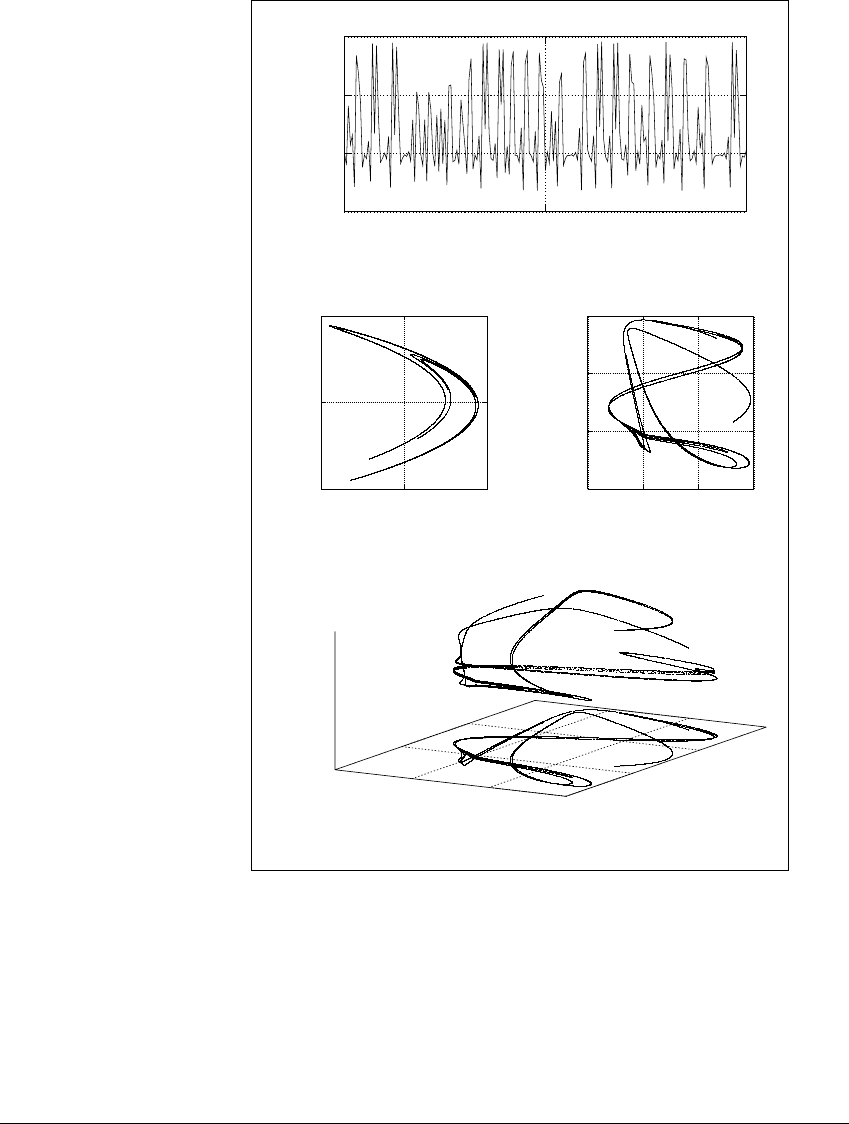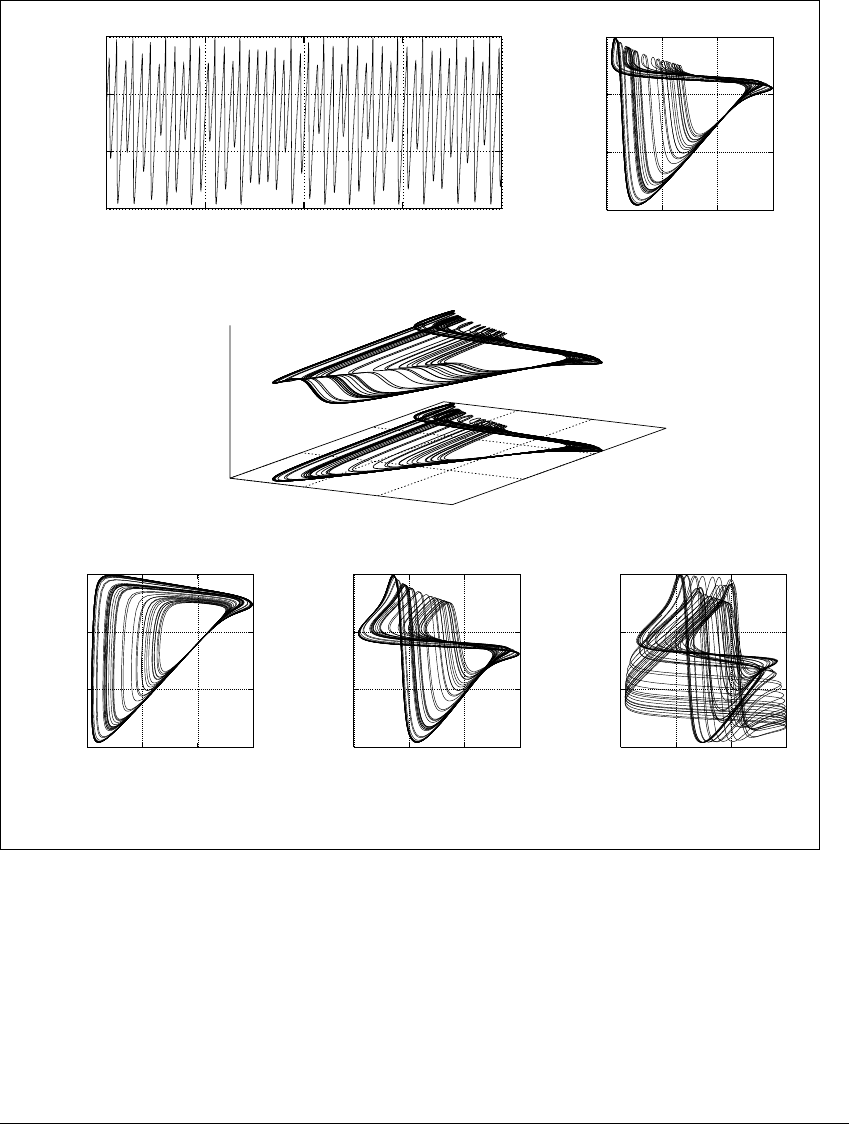Alligood K., Sauer T., Yorke J.A. Chaos: An Introduction to Dynamical Systems
Подождите немного. Документ загружается.


S TAT E R ECONSTRUCTION FROM DATA
-4
-2
0
2
0 100 200
h(i)
i
(a)
-2
0
2
-2 0 2
y
x
-4
-2
0
2
-4 -2 0 2
h(i-1)
h(i)
(b) (c)
h(i)
h(i-1)
h(i-2)
(d)
Figure 13.8 H
´
enon attractor reconstructed from a time series.
(a) A time series of the function h(i) ⫽ y
i
⫺ 3 sin(x
i
⫹ y
i
), where x
i
and y
i
are taken
from the H
´
enon attractor in (b). (c) A two-dimensional delay reconstruction of the
attractor. (d) A three-dimensional reconstruction. The projection of this set onto
the horizontal plane is seen in (c).
550

13.3 EMBEDOLOGY
1.4
1.6
1.8
2
0 3 6 9 12
Br+ concen.
time
1.4
1.6
1.8
2
1.4 1.6 1.8 2
B(t-T)
B(t)
(a) (b)
B(t)
B(t-T)
B(t-2T)
(c)
1.4
1.6
1.8
2
1.4 1.6 1.8 2
B(t-T)
B(t)
1.4
1.6
1.8
2
1.4 1.6 1.8 2
B(t-T)
B(t)
1.4
1.6
1.8
2
1.4 1.6 1.8 2
B(t-T)
B(t)
(d) (e) (f)
Figure 13.9 Belousov-Zhabotinskii reaction data.
(a) Time series of bromide ion concentration, provided by Anke Brandstater.
(b) Two-dimensional delay reconstruction of the BZ attractor, with time delay
T ⫽ 0.05. (c) Three-dimensional reconstruction whose projection is (b). The re-
maining three panels show delay plots with three different choices of delay time T.
(d) T ⫽ 0.02 (e) T ⫽ 0.1(f)T ⫽ 0.4
551

S TAT E R ECONSTRUCTION FROM DATA
happen during the time spanned by a single delay coordinate vector, the state
that the vector specifies will have limited value for applications like prediction.
Entire books have been written about state reconstruction from data and
the scientific applications that follow. Ott, Sauer, and Yorke, 1994 is a starting
point for further exploration.
552

C HALLENGE 13
☞ C HALLENGE 13
Box-Counting Dimension and Intersection
H
OW LARGE does a space have to be so that two sets can move around
and generally avoid one another? The x-axis and y-axis of the plane intersect at
the origin. If we move either or both of them slightly, they still intersect, at a
point somewhere near the origin. But if we add another dimension, they hardly
ever intersect. The x and y axes in ⺢
3
intersect at the origin, but a small push of
either one in almost any direction (except a push precisely along the xy-plane)
eliminates the intersection.
In Challenge 13 we want to explore and eventually prove the fact that two
sets of dimension d
1
and d
2
sitting in ⺢
m
usually don’t intersect if d
1
⫹ d
2
⬍ m.By
dimension, we mean box-counting dimension. There are interesting applications
of this fact for fractal sets. By “usually”, we mean that intersections are possible
but that they are unusual cases in some sense—a little push, or spatial translation,
causes the intersections to disappear. The x and y axes have dimensions d
1
⫽ 1
and d
2
⫽ 1, so d
1
⫹ d
2
⫽ 2. Two lines in a Euclidean space of dimension three or
more should intersect only if they are placed just so.
Certainly we can make any two nonempty sets intersect by moving them
so that they have a point in common. If the intersection is robust, the sets should
still intersect if they are moved a small amount. This is the situation for two lines
in the plane, but not for two lines in ⺢
3
.
What do we mean by moving the sets? We could allow many kinds of
rigid motions, that change the location of the set without changing the relative
positions of the points in the set. To keep things simple, let’s restrict our movement
to spatial translations, which are the result of vector addition of a single point to
each of the sets. Adding the vector (1, 1) to a set in the plane moves the set one
unit up and one unit to the right. We might as well let one of the two sets stay
fixed and move the other, to simplify matters.
Let S be a subset of ⺢
m
,andletv be a point in ⺢
m
. We will call the set
S ⫹ v ⫽ 兵s ⫹ v : s in S其 the translation of the set S by v. The translated set is
found by adding v to each point in S, in other words, moving S rigidly to a
new location specified by v. For two subsets S
1
and S
2
of ⺢
m
,wewillsaythatthe
translates of S
1
almost never intersect S
2
if the set 兵v in ⺢
m
:(S
1
⫹ v) 傽 S
2
⫽⭋其
has m-dimensional volume zero. This definition is symmetric in S
1
and S
2
;itis
553

S TAT E R ECONSTRUCTION FROM DATA
equivalent that the translates of S
2
almost never intersect S
1
. We can now restate
our goal in these more precise terms:
Theorem 13.5 Let S
1
and S
2
be subsets of ⺢
m
of box-counting dimensions d
1
and d
2
, respectively. If d
1
⫹ d
2
⬍ m, then the translates of S
1
almost never intersect
S
2
.
In this sense, the x and y axes always intersect in ⺢
2
, but almost never
intersect in ⺢
3
. To see the latter, notice that of all possible translations in ⺢
3
,
only those of form v ⫽ (x, y, 0) preserve the intersection. This exceptional set
of translations corresponds to the xy-plane, which is a set of three-dimensional
volume 0.
Challenge 13 has three parts. The first two concern self-intersection inside
the real line, which refers to the case S
1
⫽ S
2
and m ⫽ 1. The Cantor middle-
third set has dimension greater than 1 2, so the Theorem does not apply. In
fact, you will show that every translation of the Cantor set S
1
⫹ v intersects
the (untranslated) Cantor set S
2
, provided ⫺1 ⬍ v ⬍ 1. Second, we consider the
middle three-fifths Cantor set, which has dimension less than 1 2. A pair of these
sets almost never intersect under translation, which is consistent with Theorem
13.5. Finally, you will put together a proof of the theorem.
We learned earlier that the box-counting dimension of the middle-third
Cantor set S is ln 2 ln 3 ⬇ 0.63. Because 2 ⫻ 0.63 ⬎ 1, we do not expect two
translated middle-third Cantor sets to be able to avoid one another within the
real line. In fact, Step 3 shows that for any 0 ⬍ v ⬍ 1, the translated Cantor
set S ⫹ v has a point in common with the Cantor set S. Recall that in base 3
arithmetic, the middle-third Cantor set consists of all expansions that can be
made using only the digits 0 and 2.
Step 1 Explain the fact that if x is in the middle-third Cantor set, then so
is 1 ⫺ x.
Step 2 Show that if x is in [0, 1], then x can be written as the sum of two
base 3 expansions each of which use only the digits 0 and 1.
Step 3 Let v be any number in [0, 1]. Then (v ⫹ 1) 2isalsoin[0, 1]. Use
Step 2 to show that v ⫹ 1 is the sum of two numbers belonging to the middle-third
Cantor set S. Use Step 1 to conclude that there is a number in S which when
added to v gives another number in S. Therefore for each number v in [0, 1], the
set S ⫹ v intersects with S.
The next three steps refer to the middle-3/5 Cantor set K(5). This set is
analogous to the middle-third Cantor set, except that we remove the middle 3 5
554

C HALLENGE 13
0
1
0
1
.0
.00
1/5
.4
4/5
.44
.40
.04
1/25
4/25
21/25
24/25
0
1
1/5
4/5
Figure 13.10 The middle three-fifths Cantor set construction.
At each step, the middle three-fifths of each remaining interval is removed. This
Cantor set contains all numbers whose base 5 expansion can be made with only
the digits 0 and 4. The set denoted .04 consists of all numbers in the interval [0, 1]
whose expansion begins with .04.
of each remaining interval instead of the middle one-third. See Figure 13.10 for
a schematic view of the construction.
Step 4 Verify that the middle-3/5 Cantor set consists of all numbers in
[0, 1] possessing a base 5 expansion containing only the digits 0 and 4. Find the
box-counting dimension of K(5). Show that if S
1
and S
2
are both the middle-3/5
Cantor set, then the dimensions satisfy d
1
⫹ d
2
⬍ 1.
Step 5 Let v be a number in [0, 1] whose base 5 expansion contains a 22
(two adjacent base 5 digits are 2). Show that S
1
⫹ v does not intersect S
2
.
Step 6 Show that the set of numbers whose base 5 expansion does not
contain a 22 is a length 0 set. Conclude that translates of the middle-3/5 Cantor
set almost never intersects itself. [Hint: Sketch the subinterval .22, which consists
of 1 25 of the interval [0, 1]. Each of the remaining subintervals .s
1
s
2
of length
1 25 have a subinterval .s
1
s
2
22, and so on. Sum up the lengths.]
Next you will prove Theorem 13.5. Assume that S
1
and S
2
are bounded
subsets of ⺢
m
of box-counting dimensions d
1
and d
2
, respectively. Put down an
⑀
-grid over ⺢
m
for some
⑀
⬎ 0. Consider two
⑀
-cubes, one containing points of
S
1
and the other containing points of S
2
. To begin, Step 7 asks you to find out
how likely it is for the two cubes to intersect under translation.
555

S TAT E R ECONSTRUCTION FROM DATA
Step 7 Let C
1
and C
2
be m-dimensional cubes of side
⑀
chosen from the
grid in ⺢
m
. Show that the subset of points v such that the translation C
1
⫹ v
intersects C
2
is less than C
⑀
m
, for some constant C.[Hint:DenotebyP
1
and P
2
the centers of the cubes. The cubes can’t intersect unless the distance between
P
1
⫹ v and P
2
is less than
m
⑀
. Show that the cubes don’t intersect as long as v
avoids the ball of radius
m
⑀
centered at P
2
⫺ P
1
.]
Step 8 Let N
1
(
⑀
) be the number of
⑀
-cubes covering S
1
,andN
2
(
⑀
)bethe
number covering S
2
. The number of pairs of
⑀
-cubes, one from S
1
and one from
S
2
,isN
1
(
⑀
)N
2
(
⑀
). Denote by B
m
(r) the set of points in ⺢
m
within a distance r
of the origin. Use Step 7 to conclude that the subset of B
m
(r) corresponding to
vectors v that cause any of these pairs to collide under translation by v has volume
at most CN
1
(
⑀
)N
2
(
⑀
)
⑀
m
,whereC is a constant.
Step 9 Use the definition of box-counting dimension and the assumption
that d
1
⫹ d
2
⬍ m to prove that the volume in Step 8 goes to zero as
⑀
→ 0. Thus
the volume of translating vectors within B
m
(r) which cause any intersections of
the translated S
1
with S
2
is zero. This is true no matter how large r is, so the
translates of S
1
almost never intersect S
2
.
Postscript. Theorem 13.5 and its proof in Step 9 are closely related to Theorems
13.3 and 13.4. To achieve the embedding in Theorem 13.3 it is necessary for the images
of distant sections of the attractor in state space to almost always miss each other in
reconstruction space
⺢
m
. It can be shown that small linear perturbations of the function
F :
⺢
k
→ ⺢
m
in Theorem 13.3 have a similar effect as rigid translations in Theorem 13.5.
Since the distant sections each have box-counting dimension d, the necessary condition
of Theorem 13.5 amounts to 2d ⬍ m in the notation of Theorem 13.3. Theorem 13.4
follows from showing that small perturbations of the scalar measurement function h alone
are sufficient to restrict self-intersections to occur with probability zero. See (Sauer, Yorke,
and Casdagli, 1991) for full details.
556

A PPENDIX A
Matrix Algebra
I
N THIS APPENDIX we review important concepts from matrix algebra.
A.1 EIGENVALUES AND EIGENVECTORS
Definition A.1 Let A be an m ⫻ m matrix and x a nonzero m-dimensional
real or complex vector. If Ax ⫽
x for some real or complex number
,then
is
called an eigenvalue of A and x the corresponding eigenvector.
For example, the matrix A ⫽
13
22
has an eigenvector
1
1
,andcor-
responding eigenvalue 4.
557

M ATRIX A LGEBRA
Eigenvalues are found as roots
of the characteristic polynomial det(A ⫺
I). If
is an eigenvalue of A, then any nonzero vector in the nullspace of A ⫺
I
is an eigenvector corresponding to
. For this example,
det(A ⫺
I) ⫽ det
1 ⫺
3
22⫺
⫽ (
⫺ 1)(
⫺ 2) ⫺ 6
⫽ (
⫺ 4)(
⫹ 1), (A.1)
so the eigenvalues are
⫽ 4, ⫺1. The eigenvectors corresponding to
⫽ 4are
found in the nullspace of
A ⫺ 4I ⫽
⫺33
2 ⫺2
(A.2)
and so consist of all nonzero multiples of
1
1
. Similarly, the eigenvectors corre-
sponding to
⫽⫺1 are all nonzero multiples of
3
⫺2
.
If A and B are m ⫻ m matrices, then the set of eigenvalues of the product
matrix AB is the same as the set of eigenvalues of the product BA. In fact, let
be an eigenvalue of AB,sothatABx ⫽
x for some x ⫽ 0.If
⫽ 0, then
0 ⫽ det(AB ⫺
I) ⫽ det(AB) ⫽ (det A)(det B) ⫽ det(BA ⫺
I),
so
⫽ 0 is also an eigenvalue of BA.If
⫽ 0, then ABx ⫽
x implies BA(Bx) ⫽
Bx.NotethatBx ⫽ 0 because
⫽ 0andx ⫽ 0. Therefore Bx is an eigenvector
of the matrix BA with eigenvalue
.
A generalization of this fact is Lemma A.2.
Lemma A.2 If A
1
,...,A
n
are m ⫻ m matrices, then A
1
⭈⭈⭈A
n
and the
cyclic permutation A
r⫹1
⭈⭈⭈A
n
A
1
⭈⭈⭈A
r
have the same set of eigenvalues, where
1 ⱕ r ⱕ n.
This follows from the previous paragraph by setting A ⫽ A
1
⭈⭈⭈A
r
and B ⫽
A
r⫹1
⭈⭈⭈A
n
.
Definition A.3 The m ⫻ m matrices A
1
and A
2
are similar, denoted
A
1
⬃ A
2
, if there exists an invertible m ⫻ m matrix S such that A
1
⫽ SA
2
S
⫺1
.
Similar matrices have identical eigenvalues, because their characteristic
polynomials are identical:
A
1
⫺
I ⫽ SA
2
S
⫺1
⫺
I ⫽ S(A
2
⫺
I)S
⫺1
(A.3)
558

A.1 EIGENVALUES AND E IGENVECTORS
implies that
det(A
1
⫺
I) ⫽ (det S) det(A
2
⫺
I)detS
⫺1
⫽ det(A
2
⫺
I). (A.4)
If a matrix A has eigenvectors that form a basis for R
m
,thenA is similar to
a diagonal matrix, and A is called diagonalizable. In fact, assume Ax
i
⫽
i
x
i
for
i ⫽ 1,...,m, and define the matrix
S ⫽
x
1
⭈⭈⭈ x
m
.
Then one can check that the matrix equation
AS ⫽ S
1
.
.
.
m
(A.5)
holds. The matrix S is invertible because its columns span R
m
. Therefore A is
similar to the diagonal matrix containing its eigenvalues.
Not all matrices are diagonalizable, even in the 2 ⫻ 2 case. In fact, all 2 ⫻ 2
matrices are similar to one of the following three types:
1. A
1
⫽
a 0
0 b
2. A
2
⫽
a 1
0 a
3. A
3
⫽
a ⫺b
ba
Remember that eigenvalues are identical for similar matrices. A matrix is similar
to case 1 if there are two eigenvectors that span ⺢
2
; a matrix is similar to case 2 if
there is a repeated eigenvalue with only one dimensional space of eigenvectors;
and to case 3 if it has a complex pair of eigenvalues.
The proof of the fact that the three types suffice for 2 ⫻ 2 matrices fol-
lows from the Cayley-Hamilton Theorem, which states that a matrix satisfies its
characteristic equation.
Theorem A.4 (Cayley-Hamilton) If P(
) is the characteristic polynomial of
the matrix A, then P(A) ⫽ 0 (as a matrix equation).
559
